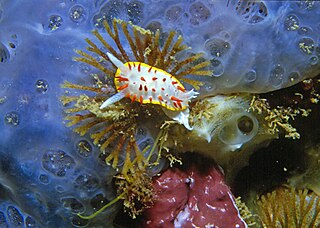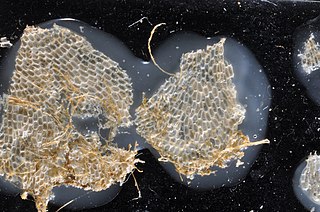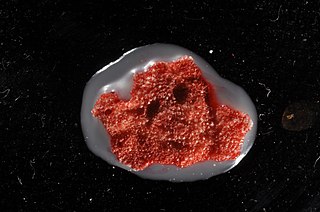
Cheilostomatida, also called Cheilostomata, is an order of Bryozoa in the class Gymnolaemata.

Bugula is a genus of common colonial arborescent bryozoa, often mistaken for seaweed. It commonly grows upright in bushy colonies of up to 15 cm in height.

Ascophora is an infraorder under order Cheilostomatida of the Bryozoa.

Flustrina is a suborder under the order Cheilostomatida of gymnolaematan Bryozoa.

The Catenicellidae are a family of bryozoans in the suborder Flustrina.
The Adeonellidae is a family within the bryozoan order Cheilostomatida. Colonies are often upright bilaminar branches or sheets. The zooids generally have one or more adventitious avicularia on their frontal wall. Instead of ovicells the adeonids often possess enlarged polymorphs which brood the larvae internally.
Beaniidae is a small bryozoan family in the cheilostomatan suborder Flustrina and superfamily Buguloidea. Their zooids have a weak box-like shell of calcium carbonate as most Flustrina, and in this family typically arranged disjunctly, connected by small tubes, and often boat-shaped. One species, Amphibiobeania epiphylla, is the only known amphibious bryozoan known as of 2008/09.

Thomas Hincks was a British Unitarian minister and a naturalist known for his work on zoophytes and bryozoa.

Schizoporella is a genus of bryozoans in the family Schizoporellidae.
Stomatoporina is a genus of stenolaematan bryozoans. The type species is Stomatoporina incurvata. Like almost all bryozoans, it is colonial.

Bugula neritina is a cryptic species complex of sessile marine animal in the genus Bugula. It has a practically cosmopolitan distribution, being found in temperate and tropical waters around the world, and it has become an invasive species in numerous locations. It is often found in hard substrates, such as rocks, shells, pillars and ship hulls, where it can form dense mats, contributing to biofouling. B. neritina is of biomedical interest because it harbors a bacterial symbiont that produces a group of bioactive compounds with potential applications in the treatment of numerous diseases.

Fenestrulina is a genus within the bryozoan order Cheilostomatida. It is the only member of the family Fenestrulinidae. It has a world-wide distribution.

Conopeum is a genus of marine and brackish water bryozoans belonging to the family Electridae. The genus has cosmopolitan distribution.

Bugulidae is a family of bryozoans belonging to the order Cheilostomatida.
Buskia is a genus of bryozoans belonging to the family Buskiidae.
Bugulina is a genus of bryozoans in the family Bugulidae.
Escharella is a genus of bryozoans belonging to the family Escharellidae.

Figularia is a genus of bryozoans belonging to the family Cribrilinidae.

Jullienula is a genus of bryozoans belonging to the family Cribrilinidae.

Rhynchozoon is a genus of bryozoans belonging to the family Phidoloporidae.














